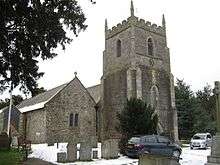Church of England border polls 1915–1916

The Church of England border polls 1915–1916 were a series of referendums held in January and February 1915, with second polls being held in March 1916, for residents of those living in nineteen Church of England parishes whose boundaries crossed the England–Wales border.[1] They were carried out to determine if the parish residents wished for their parish to remain part of the Church of England or to join the newly-disestablished Church in Wales under the Welsh Church Act 1914. The polls eventually resulted in all but one of the border parishes voting to remain with the Church of England.
Background
The Welsh Church Act 1914 was passed by parliament to disestablish the Church of England in Wales. Section 9 of the Act provided for the Ecclesiastical Commissioners to hold referendums in the nineteen areas defined as "border parishes", parishes whose ecclesiastical boundaries overlapped with the temporal boundary between England and Wales, to decide if the parish wanted to join the disestablished Church in Wales or remain part of the established Church of England.[2] The Welsh Church Act had the provision that the Church in Wales parishes would no longer receive endowments granted to them after 1662 (though this was later compensated for by the Welsh Church (Temporalities) Act 1919).[3]
Electorate
The eligibility to vote in the ballots was extended to all men and women over 21 who lived in the respective parish.[1] This extended the voting franchise beyond the Local Government Act 1894. It was one of the first examples of universal suffrage in the United Kingdom prior to the introduction of the Representation of the People (Equal Franchise) Act 1928, which gave women the same voting rights as men in parliamentary elections.[1]
Results
The results of the referendums were announced in the House of Commons by the Home Secretary, Reginald McKenna.[4] In it, all parish results published voted for remaining part of the Church of England. The ballots in Llansilin and Rhydycroesau were unpublished as they were deemed as too close to call therefore a second referendum was held in March 1916, with Rhydycroesau voting to remain with the Church of England and Llansilin being the only parish to vote in favour of joining the Church in Wales.[5][1] Because of the results, when disestablishment did happen in 1920, parishes and churches which were in a Welsh diocese were transferred to nearby Church of England dioceses for episcopal oversight. For example Holy Trinity Church, Sarn in Wales was part of the Diocese of St David's but as that became a diocese of the Church in Wales, they were transferred to the Church of England's Diocese of Hereford.[6][7]
| Parish | Ballots issued | Votes for Church of England | Votes for Church in Wales | Spoilt ballots |
|---|---|---|---|---|
| Alberbury | 414 | 273 | 28 | 15 |
| Brampton Bryan | 211 | 168 | 23 | 8 |
| Brilley with Michaelchurch-on-Arrow | 244 | 192 | 27 | 5 |
| Churchstoke | 596 | 390 | 70 | 31 |
| Dixton Newton | 304 | 209 | 29 | 17 |
| Dodleston | 430 | 279 | 93 | 49 |
| Great Wollaston | 242 | 173 | 37 | 14 |
| Hyssington with Snead | 185 | 108 | 33 | 17 |
| Kentchurch with Lagan | 213 | 107 | 38 | 7 |
| Lache-cum-Saltney | 1,640 | 854 | 228 | 76 |
| Llansilin | 228 | 255 | ||
| Llanymynech | 526 | 315 | 130 | 23 |
| Lydham | 108 | 91 | 6 | 11 |
| Mainstone | 143 | 85 | 20 | 28 |
| Middleton | 188 | 156 | 16 | 9 |
| Rhydycroesau | 98 | 78 | ||
| Old Radnor | 508 | 344 | 99 | 30 |
| Presteigne with Discoed | 1,059 | 595 | 289 | 52 |
| Sarn | 282 | 140 | 96 | 21 |
References
- 1 2 3 4 Roberts, Nicholas. "THE HISTORICAL BACKGROUND TO THE MARRIAGE (WALES) ACT 2010" (PDF). University of Reading: 16. Retrieved 2016-09-09.
- ↑ "Welsh Church Act 1914". Legislation.gov.uk. 1991-02-01. Retrieved 2016-09-09.
- ↑ Watkin, Thomas Glyn (2012). The Legal History of Wales. University of Wales Press. ISBN 0708326404.
- ↑ "Welsh Church Bill (Balloting).". Hansard. 1915-03-02. Retrieved 2016-09-09.
- ↑ "Journal of Welsh religious history – Vol. 3 1995 The records of the Welsh Church Commission held in the National Library of Wales : a brief guide". National Library of Wales. Retrieved 2016-09-09.
- ↑ "Sarn: Holy Trinity, Sarn – Powys – Diocese of Hereford". Church of England. 2015-11-02. Retrieved 2016-09-09.
- ↑ "At the Court at Osborne House, Isle of Wight, the 1st day of August, 1860." (PDF). The London Gazette: 2867. 1860-08-03. Retrieved 2016-09-09.